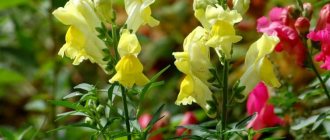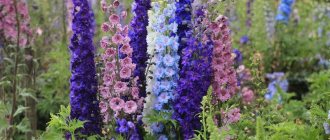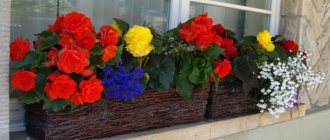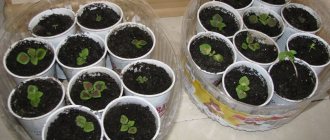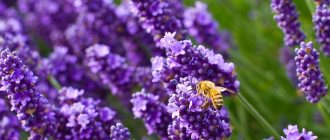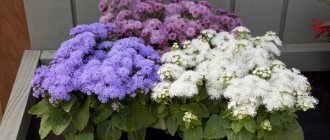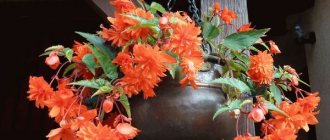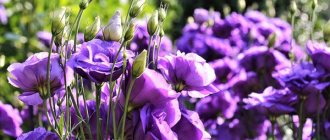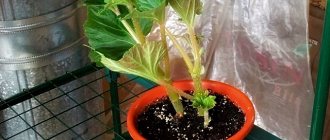Begonia is a perennial flowering plant. Flowers are simple, double, semi-double, of various colors and shades. It blooms from June until frost; in indoor conditions, the flowering period lasts up to 8 months. Does not tolerate negative temperatures.
The ampelous varieties of this plant differ from the usual ones in the direction of growth. The stems grow horizontally and hang down under their own weight in flowerpots or pots. The ampelous characteristics are most pronounced in tuberous and Bolivian begonias; other varieties most often have a bush-like form.
Among flower growers, the most popular series of hanging begonias is “Chanson”. The flowers of plants in this series are double, large, numerous, and of various colors. There are pink, white, yellow, bright red. Two-color begonias look very impressive - pink-white and orange-yellow.
The foliage is highly decorative. The carved, often asymmetrical leaves can be green, burgundy, pink or have several shades.
From planting to flowering it takes from 4 to 6 months, depending on the varietal characteristics and maintenance conditions. In the second year of development, flowering occurs in late February or early March.
Sowing begonia seeds
Growing ampelous begonia from seeds does not involve much difficulty. Unlike many other flowers, ampelous begonia tolerates planting well in the early stages. For full development, 10 hours of lighting per day is enough for her. Therefore, most often sowing begins at the end of January or beginning of February. If it is not possible to provide additional light to the seedlings in the early stages of development, it is advisable to sow later, from mid-February to early March.
Before sowing, you need to prepare: a greenhouse, seeds, soil, and a spray bottle.
Any container covered with transparent material can be used as a greenhouse. It is important to ensure good drainage; waterlogging is dangerous for seedlings.
You need to be careful when choosing seeds. They lose their viability very quickly, especially if stored at room temperature. Therefore, fresh ones are needed for sowing, preferably from last year’s harvest. The seeds are very small and are most often sold coated.
For sowing, light soil, neutral or slightly acidic, is required. Ready-made soil mixtures can be used labeled “For citrus fruits” or “For azaleas.” Also, seeds develop well in coconut or peat tablets.
In order to make a soil mixture yourself, you need the following ingredients, taken in equal parts: garden soil, humus, peat, sand. All components are thoroughly mixed, crushed or large fractions are removed, and sterilized. You can add perlite to the mixture, in which case the amount of sand is reduced by half.
It is undesirable to add ash and manure as fertilizers, even well-rotted ones. Begonia seedlings do not require large amounts of nutrients; excess nitrogen contained in manure increases the risk of fungal diseases. Ash reduces soil acidity, slowing down the development of begonias.
Drainage is laid out in the growing container, and the soil mixture is poured on top in a layer of up to 3 cm. It is necessary to leave 2 - 3 cm of free space in the container for the development of seedlings. The soil surface should be uniform, without cracks or bumps.
The seeds are placed at a distance of 1 cm, without falling asleep. Uncoated ones are simply scattered over the surface. After this, the seeds are sprayed with a spray bottle, covered, and put in a warm place. Begonia requires a temperature of 18 to 25 °C for germination.
Sowing in peat or coconut tablets has some peculiarities. There are many crevices in the fibrous structure of the tablets, so the seeds can be washed inside. In this case, they will not be able to germinate. It is advisable to add a little fine soil or sand to the surface of the tablet before sowing the hanging begonia, moisten it and level it.
Seedling care
The first shoots will appear 2 - 3 weeks after sowing. Old seeds may take longer to germinate, up to a month. The seedlings are very small and often not visible to the naked eye.
Development is very slow; it can take more than a month before the first true leaves appear. At this time, begonia is very vulnerable; it is necessary to carefully monitor the soil temperature and humidity.
Begonia develops best at temperatures from 15 to 22 °C. If the soil is colder, fungal diseases such as blackleg may appear. It is not difficult to notice the first signs of the disease; plants stop growing and quickly wither. In this case, it is urgent to treat with fungicides and replant the plants in clean soil. At higher temperatures, begonia may stretch. In addition, the soil dries out faster, making it more difficult to maintain the necessary moisture.
Water the shoots of hanging begonia from a spray bottle or pointwise from a syringe with a needle at the root. The spray bottle is set to the finest spray; large drops can break the stem. The film with which the greenhouse was covered is not removed until real leaves appear on the seedlings. Sometimes mold may appear on the surface of the soil, in which case the seedlings are sprayed with a pink solution of potassium permanganate. Most often, it does not interfere with the development of plants; after the cover is removed, the mold disappears completely.
After the true leaves appear, the begonia begins to harden off. Plants are left without shelter for half an hour, increasing the ventilation time by an hour every day. After 2 weeks, you can leave the flowers open overnight.
If necessary, the ampelous begonia is picked. The soil used is the same as for germination. You can plant plants in separate containers, for example, cassettes, or in a common one. The volume of individual containers is from 0.2 to 0.5 ml. The total size depends on the number of plants planted, the distance between them should be at least 3 cm, the height of the soil layer should be at least 5 cm. Plants sown in tablets do not need picking.
Grown plants are planted in pots or flowerpots on a leg. If the plants will be indoors, the timing of transplantation does not matter. Begonia is planted in flowerpots that are located outside after the soil has warmed up to 15 °C, having previously prepared a shelter in case of frost.
Planting ampelous begonia in the ground
Ampelous begonia is rarely grown in open ground. Most often it is used to decorate the borders of high flower beds or as a tapeworm on an alpine hill.
Most garden plants prefer alkaline soil, developing poorly in acidic soil. Begonia prefers slightly acidic soil, so neighbors in a common flower bed must be selected with the same requirements, or a separate fenced-off cell must be made for begonia.
Begonia can be planted after the soil at a depth of 10 cm has warmed to 15 °C. If the plant grew indoors, it must be prepared for contact with direct sunlight. To do this, it is taken out into the open air for several days, leaving it in partial shade. If this is not possible, the plantings are shaded with thin white fabric, fine mesh or white agrofibre. In cloudy weather, the shelter can be removed.
Caring for adult hanging begonia is simple - timely watering and fertilizing if necessary. For the winter, two-thirds of the begonia's leaves are removed, treated with fungicides and placed in a cool place with a temperature of 2 to 5 degrees Celsius. Lighting during the dormant period is not necessary.
The delicate beauty of ampelous begonia will not leave anyone indifferent; the ease of caring for an adult plant compensates for the difficulties of growing from seeds.
Is it difficult to care for a plant at home?
In fact, growing pelargonium at home is even easier than in open ground. It will be enough just to choose the optimal place where you can place the flowerpot with a pot. Window sills are best because geraniums love plenty of sunlight. However, leaving young plants in the sun during hot times of the day would be extremely unwise. Therefore, use a source of additional shading or place a flower on the eastern window.
The plant should be watered at home in the same way as in the open ground - as the substrate dries. However, the advantage of such cultivation is that the grower does not have to worry about the condition of the root system, because precipitation in the apartment is not dangerous. Although there is still no need to overwater the plant. Most professionals recommend watering geraniums about 2 times a week with well-settled water at room temperature.
If you want to get a really beautiful plant, then you will have to start shaping its crown. To do this, it is necessary to cut off old two-year-old shoots once a year (in autumn) in order to give strength to new ones. In addition, if one or another branch begins to grow in a place that is not suitable for you, then do not be afraid to pinch it. Well, if we are talking about growing climbing pelargonium from seeds, then create a special support for the plant in the early stages of development.
Secrets of growing ampelous begonia from seeds
Lately, ampelous begonia has become very popular. Depending on the species, the plant can be either annual or perennial. It combines harmony, attractiveness, temptation, tenderness, brightness. It has asymmetrical petals, a beautiful bush, and luxurious flowering. But its biggest advantage is its unpretentiousness. What could be better when you can enjoy beauty and at the same time make a minimum of effort. And in order to grow such a flower from seeds yourself, you need to know all the secrets of its cultivation. And then it will delight you and your loved ones with its rich and magnificent flowering.
Features of the plant
Begonia has many species, currently there are more than 1000 of them. This flower can often be found in South America, India, Asia, on the island of Sri Lanka, and in Africa. It blooms continuously from spring to late autumn. Begonia loves light very much, it needs regular watering and a little feeding.
In ampelous begonia, flowers appear at the level of 5 or 6 nodes. In the leaf axil there are male and female flower stalks, the diameter of which is up to 8 cm. Each bud blooms on average for 10 days, then falls off and is immediately replaced by other flowers.
Most often, this flower grows in a hanging basket or in a pot with a long stem. It is best to keep it on the south side, where the sun shines constantly. On very hot days, it is recommended to move the begonia to the east side, so you will have green leaves on the plant and it will not turn yellow.
Begonia looks beautiful in summer cottages when it decorates verandas, gazebos or just a balcony in large quantities. Many novice gardeners do not dare to buy ampelous begonia seeds and buy ready-made flowers. But how nice it will be to grow such a magnificent creature from one seed. And all the tips below can work this miracle.
Description of the plant and popular varieties
Begonia is a low growing shrub or herbaceous plant with beautiful bright flowers. The leaves and stems differ in shape and color depending on the type of flower. The following types of begonia are most often grown at home:
Ampelous - it has cascading shoots up to 45 cm long. Flowers are formed after 5-6 leaf nodes in the leaf axils. Each flower lives up to 10 days, and after falling, a new one appears in its place. Thanks to this, the plant seems to bloom continuously until late autumn. The most popular variety of hanging begonia is considered to be Chanson; it has beautiful white or yellow lush flowers.
Tuberous - has a tuberous rhizome and a tall fleshy stem, which reaches a height of about 80 cm. There are varieties with simple and double flowers that resemble roses, camellias, carnations or peonies. Flowers can be small, up to 3 cm in diameter, or large, up to 20 cm in diameter. They can be located singly or in inflorescences. The most popular varieties of tuberous begonia are Duck Red, Picoti Harlequin, and Bouton de Rose.
Ever-blooming is a complex hybrid that combines all varietal qualities. It is a low-growing shrub with fleshy stems and smooth, heart-shaped leaves. Flowers can be painted white, pink and red, collected in various inflorescences. Among the ever-blooming begonias are terry varieties, the flowers of which have a huge number of petals. They resemble small roses. In total, there are about 600 varieties of ever-flowering begonia, among which the most commonly grown at home are Ray, Queen, and Cocktail.
Bolivianum is a tuberous plant with long drooping stems that grow up to 80 cm and hang down in several tiers. The flowers are formed in several pieces on short peduncles and have a bright orange color. This type of begonia is suitable for growing in pots and containers, as it grows well in a small amount of soil. The most common varieties of this species can be called Santa Cruz, Bonaparte, Belavista.
Soil and seed preparation
Before you start sowing, you need to prepare the soil and seeds in advance. Let's start with the seeds. They need to be prepared several weeks before sowing. Begonia is usually planted in late February or early March. There are a lot of seeds in the bag and you need to be careful with them. It is advisable to mix them with sand before planting. But most often they are sold in the form of granules and this makes sowing much easier.
As for the container and soil where you need to plant begonia seeds, here you need to buy a special box and a peat tablet. You can also buy soil at the store or prepare it yourself. For this you will need:
- one part peat;
- one part sand;
- two parts of leafy soil.
All this is mixed and poured into a container where the begonia will continue to grow. It is very easy to grow begonia from seeds and you do not need to buy ready-made seedlings.
When everything is ready for planting, you first need to pour drainage into the container. This is done so as not to over-moisten the soil. Because in such a case, decay may occur. For drainage, you can choose small pebbles, pebbles or glass beads. Now you can lay out the soil you made. Then use a spray bottle to lightly moisten it. The soil should be moist, not wet.
Now you can spread the seeds over the entire surface and lightly press them to the ground, but there is no need to immerse the seeds inside. There is no need to put anything on top. If you use a peat tablet, then you need to make sure that the soil does not dry out. Cover the top with glass or cling film and place on the windowsill, on the south side.
The temperature in the room should be from 20 to 27 degrees Celsius. It is necessary to wet the soil using a spray bottle or through a tray, since a direct stream can wash away the seeds. The first shoots can be seen after nine days.
Begonia propagation: basic methods
Begonia propagates in several ways: tubers, vegetative methods, stem cuttings, leaves or seeds. Most people choose to grow begonia seedlings from seeds, which is not difficult. In appearance, the seeds of this plant are very small and do not have good germination. However, if you follow all the features of growing begonia from seeds, you can get excellent planting material.
There are many varieties of this flower. Where there are subshrubs and shrubs, annuals and perennials, double and empty varieties, single-color and bicolor. Therefore, each gardener chooses for himself what to plant on his plot. Of course, you can buy a ready-made bush in a store or market, but there is no certainty that a person will buy what he needs. Therefore, begonia propagation can be mastered independently.
Planting and dividing a begonia tuber
With the onset of the end of summer, begonia reduces flowering and goes to rest, so you need to decide: dig up the tubers or leave the flower to continue to bloom indoors. To propagate and plant begonias with tubers, you will have to make an effort. First, the bush must be dug up along with the ground and placed in a dry place without cutting off its leaves and stems. The best option for storing it is in a ventilated place where there is no moisture. Since the leaves of the plant dry in the fall, all the nutrients are collected in the tuber. As a result of such features, a large tuber is formed within a month. To prevent this root from drying out over the winter, it is placed for storage in a box with dry peat or sand.
It is very important to know that the tubers can dry out during the winter. To prevent this, you need to occasionally moisten the substrate in which they are stored. And if everything is done correctly, then in the spring the flower tubers can be planted in the ground. The question immediately arises: how to plant begonia to get abundant flowering and a healthy bush? During planting, the tubers are positioned in such a way that the smooth lower part is at the bottom, and the more concave part, which has buds, is at the top. These differences can be determined with the naked eye, so even an inexperienced amateur gardener can cope with this. The place where the buds are located is more lumpy and uneven, so it is easy to identify.
If you have a good, large begonia tuber, then, if desired, it can be divided into several parts, which will allow you to get several young plants at once.
Many flower lovers are interested in how to grow begonia from a tuber and what to do for this? If there is a healthy, strong tuber, it is divided into parts, each of which is about 5-8 cm in size. It is very important that each such piece has a bud. After dividing, the cut site is sprinkled with ash, and parts of the tubers are placed in separate pots with moistened soil. The divisions are arranged vertically.
After planting, the pots should be covered with film and placed on a well-lit windowsill so that the plant can give new roots. After a while, several leaves will appear on the seedling, after which the film is removed. During the propagation of the tuber, and when the young bush develops in a pot, it needs to be fed periodically so that the begonia becomes a strong, healthy and beautiful plant. Only under good growing conditions will it delight its owners with lush greenery and abundant flowering.
Dividing begonias by cuttings
Ampelous begonia is usually propagated using the stem method. To do this, select a strong cutting that has at least two buds; it is cut at the bottom at an acute angle, leaving 5 mm from the bud. All large leaves that are present on the branch are cut off in half. Now part of the stem is ready for planting. Next, you need to make a sufficient hole in the substrate and place a twig there. For this, pots or open ground are used, but in any case, the cuttings must be covered with a bag or jar to create a greenhouse effect. The container must be removed twice a day to ventilate the soil and the young seedling.
Sometimes gardeners, instead of a jar or bag, use a regular plastic bottle with the bottom cut off. If condensation appears on its walls, then the lid is removed from the neck, and after it disappears, it is screwed on again. If propagation of begonia by cuttings was correct, then after 15-20 days the branch will form roots. When a flower is propagated in this way, each cutting behaves differently. For example, some develop very quickly, while others may stop growing for a while.
To plant cuttings, a special substrate is used, for the preparation of which a mixture of sand and peat is taken with a ratio of 3:1. The most suitable temperature for growing should be at least +22 degrees. Also, cuttings from begonia stems take root well in water, but for this the water temperature must be from +22 degrees. To plant rooted stems, prepare a soil mixture, for which you take equal quantities of greenhouse soil, manure, high-moor peat, algae and a little river sand. The most suitable container for planting is a pot with a diameter of 14 cm that has good drainage.
Landing in the ground
Begonias are planted in the ground at the end of May, when the weather is more or less stable and frosts are not predicted. If you are in the northern region, you can wait until the beginning of June. It is advisable to check the weather for a week in advance in order to have time to take care of the plant. If it rains, you can cover the seedlings with polyethylene or lutrasil.
You need to plant it immediately in a prepared hole, which is filled with a special soil composition. For the first three weeks, it is necessary to constantly feed the plant.
There is no need to worry that the begonia will stop growing. Even in extreme heat this can be avoided. It is enough to increase the volume of liquid for irrigation.
Growing ampelous begonia from seeds at home
In modern apartments, housewives grow a huge variety of flowers. Ampelous begonia occupies a special place in this process.
It is better to propagate this flower by seeds. Even tuberous begonias are best propagated by seeds. Growing ampelous begonia from seeds at home is most preferable for several reasons. Firstly, it is more economical, since seeds are much cheaper than tubers, and secondly, storing seeds is much easier. Although this process will take much longer, this does not frighten avid gardeners.
Begonias are quite attractive to look at, regardless of whether they are foliage or floral. Particular attention should be paid to hanging begonia, since it can decorate not only a room, but also a balcony and terrace. This indoor plant is quite unpretentious, but at the same time it always looks festive and beautiful.
Pests and diseases
Ampelous begonia is not a painful plant, but it can also have troubles. This is gray rot - rot on the leaves and shoots of a flower; powdery mildew - white coating on leaves; Bacterial spot is a disease of the back side of begonia leaves. Spraying with special solutions will help against these misfortunes.
Among the insects that cause harm are the soft scale insects, aphids, whiteflies and others. Spraying is also suitable to combat them (select a product based on the parasite), and in some cases it may be necessary to remove part of the plant.
Try growing ampelous begonia next summer and you will be delighted with this flower. Tender or passionate - it will lift your mood in any case.
How to prepare soil for sowing
Sowing of hanging begonia should be done in soil that is close to neutral or slightly acidic. Almost all begonia varieties do not tolerate acidic soil. The task is somewhat simplified if you go to a flower shop and purchase exactly the composition of the substrate that is suitable for begonias. At the same time, it is not at all difficult to prepare a soil mixture yourself if you mix leaf and turf soil with sand, adding a little perlite or vermiculite. A mandatory step is disinfection of the composition. Begonias have rather delicate and fragile leaves and stems, so they are very often affected by fungus. You can use several options:
- Freeze the soil for a while;
- Treat the substrate with boiling water;
- Treat the soil with a weak solution of potassium permanganate;
- Cultivate the soil with steam;
Seeds can be sown in any container that is convenient to cover it, creating a greenhouse effect.
How to sow ampelous begonia seeds
First you need to decide when to sow ampelous begonia seeds. The most appropriate terms are the month of January or the beginning of February. During this time, healthy, large begonia tubers will have time to form. Sowing the seeds is complicated by the fact that they are very small, so you will have to work with tweezers. If you purchase glazed seeds, the process can be somewhat simplified, because they are slightly larger.
Immediately before sowing, the soil should be moistened with a sprayer. The seeds are simply scattered over the surface of the soil and covered with film. Glazed seeds can be sown in peat tablets, but then they still need to be tightly covered to create a greenhouse effect.
As indicated on the package, the seeds will hatch after 2-3 weeks. High-quality seeds, under appropriate conditions, almost everything germinates. The temperature conditions for seed germination must correspond to +25ºС, and they must be in a lighted place. During the germination process, the seeds are not watered, but simply moistened with a sprayer.
Selection of planting material
Growing hanging begonia varieties “Chanson” and “Gavrish Alkor F1” from seeds is not difficult. Today seeds are sold in two varieties.
- Regular seeds. They are inexpensive, sold in almost any specialty store and are very small in size. They are planted only in wide containers with soil. This material is not suitable for planting into tablets or cups individually.
- Granulated or glazed seeds. They are quite large in size; they are sown only one per hole. The advantage of such seeds is their size and ease of planting.
Everyone decides for themselves which planting material to give preference to.
The main thing is to remember that it is better to purchase seeds with a reserve. For example, if 10 begonia seedlings are needed, then the number of seeds should not be less than 20 pieces.
Caring for young seedlings
After the green shoots appear, they should be kept under the film for some time, ventilated from time to time, so that the tender shoots do not catch any infection. At the same time, you should not expose them to the sun and do not allow the soil to dry out.
Water only with a sprayer or through a tray so as not to harm young and tender shoots. When young shoots appear, it is better to lower the temperature to +20ºС, but the lighting intensity needs to be high. They must be exposed to lighting for at least 14 hours a day, otherwise they will not grow.
Picking seedlings
After 60 days, the young seedlings are distributed into separate containers. Moreover, for the first transplant you will not need bulky cups or pots. She does not like a lot of space, so she is replanted several times as she grows. Plants sown in January will bloom in mid-June. By May, one can already observe stronger plants, with stems hanging down, on which developed leaves are placed.
For transplanting seedlings, disposable plastic cups or yogurt containers are suitable, which should be washed thoroughly. At the bottom of the containers it is necessary to make a hole and lay a 10 cm layer of drainage. The soil for replanting is suitable the same as for sowing, but it is better to reduce the amount of sand and increase the portion of turf soil. The cups are not filled completely, leaving a space of about 1 cm high to the edges. A depression is made in the center of the cup, where the flower is planted. After this, the temperature drops to +18ºС. During this period, as a rule, there is already enough natural light.
After picking, begonia is fed only after two weeks. The flower is fed every two weeks with ready-made complex fertilizers for indoor flowers.
At the moment the buds appear, the plant needs potassium-phosphorus fertilizers. This will allow the flower to delight others with lush blooms. As a rule, the plant is fed only after watering.
Care in spring and summer
North-facing windows are best suited for growing hanging begonias; it is on them that it is recommended to hang pots with the plant.
In spring and summer, begonia needs maximum moisture. Side shoots must be pinched periodically, then the bush will grow not only in length, but also in width. Begonia blooms all summer, the flowers look like small roses, and the small leaves have a carved shape.
Caring for ampelous begonia in spring and summer
If begonia is grown at home, the room must be constantly ventilated; the plant needs fresh air. At low humidity, the air is humidified artificially, using a spray bottle or additional containers with water, which are placed next to the flower.
If the plant is exposed to the street in the summer, you need to ensure that it is not exposed to drafts, this has a bad effect on the condition of the begonia. Watering should be regular and plentiful. On particularly hot days, begonia should be bathed in the shower.
With proper care, ampelous begonia from seeds
will bloom profusely from May to October. If the care rules are not followed, the begonia may get sick or be attacked by pests.
Growing ampelous begonia using seeds is quite troublesome, since the procedure requires constant monitoring. But if a number of agrotechnical nuances are observed, the result of the work will bring extremely positive emotions. As a rule, decorative deciduous or ever-flowering varieties of begonias are grown from seeds, but tuberous crops can also be grown in the same way (although the process is quite slow, so considerable patience is required).
The ampelous form of begonias is very popular among those gardeners who love unpretentious crops with beautiful asymmetrical leaves and semi-double/double flowers. What is characteristic is that lush flowering, excellent decorative characteristics and extreme ease of care allow even novice gardeners to grow ampelous begonia.
On a note! Representatives of the family reproduce mainly by cuttings and tubers, but in some cases, the use of seeds is the only available way to obtain begonias with the required number of leaves and the required flowers.
In order for plants to be strong and healthy, they need to be provided with suitable conditions, which you should know about before you start working.
Ampelous begonia - photo
Table. Conditions for normal development
| Name | Short description |
| Lighting | Due to its light-loving nature, ampelous begonia should be placed in a well-lit place, but should not be exposed to direct rays of the sun (this can lead to burns). The light should be bright, but at the same time diffused. |
| Top dressing | The first feeding should be done when the shoots grow. As a rule, nitrogen fertilizer is used for this, which stimulates development. For subsequent feedings, it is recommended to use fertilizer that is intended specifically for begonias. From the beginning of budding and during the entire growing season, fertilizing should be applied once every two weeks - this way the flowering will be more abundant and longer. |
| Temperature | The optimal temperature for the crop - in particular for peduncles - is considered to be 20-25°C. |
| Humidity level | Low air humidity is detrimental to begonias. To achieve optimal humidity levels, the plant should be placed next to a tray of peat moss that is constantly moistened. And the air around the crop (especially on hot days) needs to be sprayed regularly, but so that water does not fall on the flower itself. |
| Watering | The plant needs to be watered regularly. If the soil dries out, the root system will simply die. The water used for irrigation must be softened and settled. |
Ampelous begonia. Propagation by cuttings
Now, having understood the features of care, let’s look at the growing procedure itself.
Contents of step-by-step instructions:
Further care for the flower
Caring for ampelous begonia at home begins from the moment it is transplanted to a permanent place. This is done at the end of May, when the flower has already formed and is ready for transplanting. Transplantation is carried out using the “transfer” method. We should not forget about drainage, for which you can use pebbles, expanded clay or broken bricks. Ampelous begonia looks good in hanging pots, where three plants are placed.
If begonia is properly cared for, it will delight others with its flowering for a long period. The ideal place for its normal development is partial shade with diffused light. It is not recommended to install it in a sunny place, as it stops blooming and may die if you do not pay attention to it. Water the flower regularly, as the top layer of soil dries, with warm, settled water.
Non-tuberous begonias can bloom for a long time, while tuberous begonias need a break. After the flowering period, all shoots should be removed and the plant moved to a cool place, followed by a reduction in watering and no feeding.
Boarding time
Begonia seeds can be sown for seedlings from the end of January until April. Everyone determines the exact sowing time independently, depending on the characteristics of the plant development cycle. To ensure that begonia blooms as early as possible, planting is carried out in January. Then, by the time the seedlings are transplanted into the ground, they will have a well-developed root system and the seedlings will quickly take root in the new location.
Begonia will produce its first flowers 5 months after sowing the seeds, so it is worth sowing them as early as possible. However, this process should not be carried out before the end of January, since weather conditions do not correspond to the natural needs of the plant.
Do not forget about the specifics of different varieties of begonia. If you sow an ever-flowering begonia early, the seedlings will already be overgrown by the time they are transplanted into open ground. It will be difficult for it to take root in new conditions because of this the plant will lose its decorative properties. The plant will begin to bloom too early and the number of buds will be much smaller. It is recommended to plant the seeds of ever-flowering begonia in February.
Tuberous begonia, on the contrary, must be sown before mid-January. Then, by the time of transplantation, the leaves and buds of the flower will have time to form.
The main thing to remember is that by choosing the right time for sowing seeds for seedlings, you will ensure the normal development of tubers and the root system of plants.
Watch the video! Growing begonia from seeds
